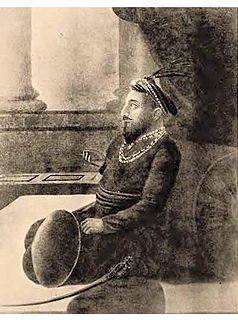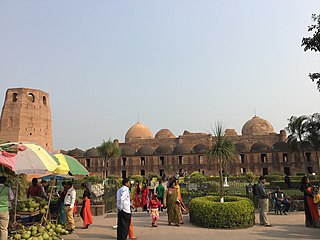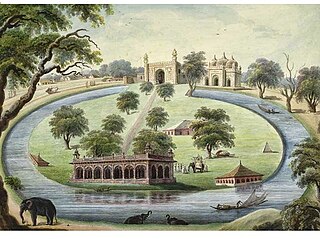
The Masjid e Jahan Numa, commonly known as the Jama Masjid of Delhi, is one of the largest mosques in India. It was built by the Mughal Emperor Shah Jahan between 1650 and 1656 at a cost of one million rupees, and was inaugurated by Imam Syed Abdul Ghafoor Shah Bukhari from Bukhara, present-day Uzbekistan. The mosque was completed in 1656 AD with three great gates and two 40 metres high minarets constructed with strips of red sandstone and white marble. The courtyard can accommodate more than 25000 people. There are three domes on the terrace which are surrounded by the two minarets. On the floor, a total of 899 black borders are marked for worshippers. The architectural plan of Badshahi Masjid, built by Shah Jahan's son Aurangzeb at Lahore, Pakistan, is similar to the Jama Masjid.

The Sunheri Mosque, also known as the Talai Mosque, is a late Mughal architecture-era mosque in the Walled City of Lahore, capital of the Pakistani province of Punjab.

The Sixty Dome Mosque, is a mosque in Bangladesh. It is part of the Mosque City of Bagerhat, a UNESCO World Heritage Site. It is the largest mosque in Bangladesh from the sultanate period (1204-1576). It was built during the Bengal Sultanate by Ulugh Khan Jahan, the governor of the Sundarbans. It has been described as "one of the most impressive Muslim monuments in the whole of the Indian subcontinent."

Indo-Persian architecture is the Indic architecture & engineering of the Indian subcontinent, often embedding some elements of architecture carried over from various parts of West and Central Asia, produced for and by Islamic regimes. Such foreign elements come from regions themselves influenced earlier by the spread of Indian architectural vocabulary with the spread of Buddhism, as Persian architecture worldwide started from the adoption, use and re-use of early pre-Islamic architectures. Despite an initial Arab presence in Sindh, the development of Indo-Persian architecture began in earnest with the establishment of Delhi as the capital of the Ghurid dynasty in 1193. Succeeding the Ghurids was the Delhi Sultanate, a series of Central Asian dynasties that consolidated much of North India, and later the Mughal Empire by the 15th century. Both of these dynasties introduced Persianate, Turkic and Persian architecture and art styles from Western Eurasia into the Indian subcontinent.

The Taj-ul-Masajid or Tāj-ul-Masjid, is a mosque situated in Bhopal, India. It is the largest mosque in India and one of the largest mosques in Asia.

Murshid Quli Khan, also known as Mohammad Hadi and born as Surya Narayan Mishra (c. 1660 – 30 June 1727), was the first Nawab of Bengal, serving from 1717 to 1727.

Shuja-ud-Din Muhammad Khan was the Nawab of Bengal. He married Zainab un-nisa Begum and Azmat un-nisa Begum, the daughters of Murshid Quli Khan by Nasiri Banu Begum. Shuja-ud-Din's third wife was Durdana Begum Sahiba. After the death of his father-in-law on 30 June 1727, he ascended to the Masnad (throne) of the Nawab.

Balapur Fort is a Mughal fortress in the town of Balapur in the Akola district of India. Construction on the fort was started by Mirza Azam Shah, the son of Emperor Aurangzeb and it was completed by Ismaeel Khan, the Nawab of Elichpur in 1757. The chhatri of Raja Man Singh I, a canopy constructed by Mirza Raja Jaisingh, has an area of 25 square feet and a height of 33 feet. Its foundations were heavily damaged in a great flood called the 'dhvdya pur' which occurred more than 100 years ago, but after some years the damage was repaired at a cost of Rs 3,000 received from Jaipur.

Mohri Sharif is a village in Tehsil Kharian, in the Gujrat District of Punjab, Pakistan. It lies midway between Lahore and Islamabad. Mohri Sharif and Kharian Tehsil have many of its population settled in European countries.

The Katra Masjid is a former caravanserai, mosque and the tomb of Nawab Murshid Quli Khan. It was built between 1723 and 1724. It is one of the largest caravanserais in the Indian subcontinent. It was built during the 18th century, when the early modern Bengal Subah was a major hub of trade in Eurasia. The Katra Masjid is located in the north eastern side of the city of Murshidabad, in the Indian state of West Bengal. The most striking feature of the structure are the two large corner towers having loopholes for musketry.

The Spanish Mosque, also known as Masjid Iqbal Ud Daula or Jam e Masjid Aiwan-E-Begumpet, is a mosque within the Paigah Palace, Begumpet, Hyderabad, India.

Motijhil, also known as Company Bagh due to its association with the East India Company, is a horse-shoe shaped lake in Murshidabad, West Bengal, India. It was created by Nawazish Muhammad Khan, the son-in-law of Nawab Alivardi Khan. He also constructed a precious palatial palace beside this lake which is called the Sang-i- dalan which is also known as the Motijhil Palace. It is located at the bend of this lake. It was used as the residence of Nawazish and Ghaseti Begum, Nawazish's beloved wife. It is said that after Nawazish died, Ghaseti Begum lived here until Nawab Siraj ud-Daulah took over the palace and seized the residents' in 1756 AD. With this money he built a similar lake with a beautiful palace, Hirajheel, on the opposite side of the Bhagirathi River. The palace has a lofty gateway, a mosque known as the "Shahamat Jang" and the Kala Masjid and some other buildings which were all built by Nawazish. This palace was built in 1740. As far as etymology is concerned, the palace has been named so as it was built using black basalt pillars which were brought from the ruins of Gaur. Thus, it was given the name of Sang-i-Dalan or the Stone Palace. This palace was then decorated with different varieties of flower plants and precious marbles.

The Chawk Mosque is a mosque in the city of Murshidabad, India. It was founded in 1767 AD by Munny Begum, wife of Nawab Mir Zafar. Earlier in this place Nawab Murshid Quli Khan had built the "Chahel Sutan", which was the city's forty pillared audience hall. The mosque still recalls the stories of the ruling days of the Nawabs and still holds on its glory of the past.

The Nizamat Imambara is a Shia Muslim congregation hall in Murshidabad, India. The present Nizamat Imambara was built in 1847 AD by Nawab Mansur Ali Khan. It was built after the old Imambara built by Nawab Siraj ud-Daulah was destroyed by the fires of 1842 and 1846. This Imambara is the largest one in India and Bengal.

The Badshahi Mosque is a Mughal era mosque in Lahore, capital of the Pakistani province of Punjab, Pakistan. The mosque is located west of Lahore Fort along the outskirts of the Walled City of Lahore, and is widely considered to be one of Lahore's most iconic landmarks.

Bibi Maryam Mosque is a masjid located in the Killarpul area of Narayanganj district in Bangladesh which was built under the period of Mughal intervention in around 1860. This masjid has been renamed in the 21st century as Killarpul Shahi Jame Masjid.

The Golden Mosque is a mosque in Old Delhi. It is located outside the southwestern corner of Delhi Gate of the Red Fort, opposite the Netaji Subhash Park.

Grand Jamia Mosque Lahore is a mosque located in Bahria Town, Lahore, Pakistan. With a capacity of 70,000 worshippers, it is the third largest mosque in Pakistan and the fourteenth largest mosque in the world.
Lucknow is a city of imambaras as it has a large number of imambaras among which are some very famous.
Azimpur Mosque is located beside the Azimpur graveyard in Dhaka. A Persian inscription in the mosque indicates that the mosque was built in 1746 AD by one Fayzul Alam. The mosque was built during the reign of Mughal Nawab Alivardi Khan and is the last existing example of a mosque structure with a single dome and a flanking half-domed vault on both sides.






















